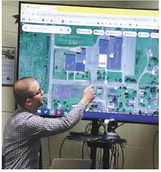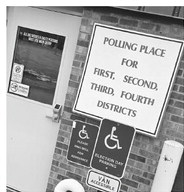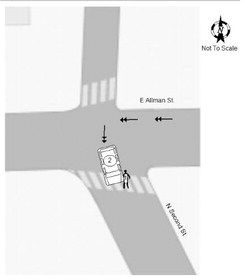Trails proposal pits privacy versus development potential
by Cheyenne Thomas
Holding an informational meeting at the Granton Community Library on Oct. 14, the Neillsville Improvement Corporation (NIC) spoke to residents of the area and members of the Granton Rotary about its proposed Rails to Trails project along the old railroad bed through the Neillsville-Granton-Chili area. After its hour-long presentation, members of NIC sat down with some of the adjacent landowners and community members for a question-and answer-session, discussing some of the concerns that have been voiced about the project.
About a dozen people showed up for the presentation, which was presented by NIC president Dan Clough and vice president Deanna Heiman. The presentation reiterated many of the key points that had been shared at previous informational meetings regarding the Rails to Trails project of constructing a non-motorized bike trail along the route. Most of the focus of the presentation centered on reversing the trend of an aging and decreasing population in local communities.
“We want to attract young people to our communities and keep them here,” said Heiman.
The proposed route roughly travels along the old railroad line that ran through Neillsville, Granton and Chili up until 1982 when the last trains were used in the area. Since then, the lines have been torn up and the land sold, with about 98 percent of the land currently owned by Xcel Energy. Clough said Xcel Energy has had 12 easement agreements with landowners along the corridor, seven of which are still valid and of those seven, only three that are actively used.
After negotiating an agreement with Xcel Energy on a conditional purchase agreement of the property, Clough said NIC entered the planning stage of the project where they have held informational meetings and tried to negotiate with residents along the route who either own a portion of the old railroad line, have easement claims, or live along the route and have concerns about the trail’s creation. Because of the nature of this next stage, Clough said the proposed route is expected to change slightly to accommodate the needs of the people involved along the route.
Once the presentation ended, some members of the group in attendance at the meeting wished to understand and hear the concerns of some of the residents who spoke at times during the presentation and who own land on or near the proposed route. The question and answer session quickly developed into a half-hour discussion between the different parties as they talked about ways concerns may be addressed or may be hard to resolve. Residents sharing their concerns were Barbara Comstock, who owns several pieces of land closer to Neillsville along the railroad corridor; Julie Reineck, who owns pieces of land near the city of Neillsville and the village of Granton; and Marge Garbisch, who also owns land near the village of Granton.
Some of the concerns these residents shared focused on problems that the landowners have had issues with in the past and they felt would only become more complicated if a trail were to be created on the route. Even with the corridor owned by Xcel Energy, they said there have often been trespassers on the property, some of whom used motorized vehicles such as trucks or ATVs. The residents said they only expect these acts of trespassing to increase with the introduction of a public trail.
“My family was ordered off my property by people who don’t own the property,” said Garbisch.
“We have property on both sides of the railroad, these things happen,” added Reineck. “People will wander onto private land.”
Tying into the issue is a concern about liability in the case of an accident if someone wanders off the trail onto their property. Though Clough said NIC will purchase insurance to cover any accidents that occur on the trail and anyone who goes onto the adjacent landowner’s private property is considered by law to be a trespasser and landowners are therefore not obligated or responsible for them, the landowners themselves seemed unconvinced.
“They can sue you … it’s just a piece of paper,” said Reineck. “If a burglar breaks into your house and hurts himself, they can sue you … insurance companies fight insurance companies so they don’t have to pay.”
“Why press our luck?” asked Comstock “It just takes one.”
Privacy was another big concern for the residents. Ever since the last train traveled through the corridor, they said the area has become quiet and private. In the past 30 years the landscape has changed to match, as landowners and easement holders have adapted the land for other uses. For them, they said too much has changed for them to be willing to become neighbors to a bustling trail.
“It’s very easy for people whose lives aren’t affected to be on board with it. It’s used as cropland, pastureland, a pond embankment,” said Reineck. “We have an interest in a bike trail, just not there. As a hunter, I don’t want bikers on it, my kids hunt on it. It’s private, we use it for private use. I don’t feel that I should feel criminal if I didn’t do it (allow the trail to go past their land) … I’m not against recreation, I am an avid walker, I hunt and ride all the time, I’m just very private.”
When asked what they would be willing to do to allow a trail to go through the area, the residents said potential trail users should be regulated to land along roadways to avoid landowners who do not wish to be disturbed. Speaking about riders’ preferences to areas away from traffic, Clough and Heiman said having the trail run along roads would not give riders a positive experience with the trail, which wouldn’t give the community the development it’s seeking.
“If you go on roads it defeats the purpose of economic development,” said Heiman.
If the trail were to be completed, Clough and Heiman said research shows that the population in the area will increase and would create a window for new businesses to be created in the area to meet the needs of the people who use the trail. The new businesses, they said, would create a better local economy and provide people with more local services than there have been in the past several years.
“It’s just a proposal,” said Clough. “We have recreation on Levis, but it’s overused. We need something else … Chili looks to benefit the most since they don’t have anything, a diner, ice cream shop, grocery store could all be built there.”




